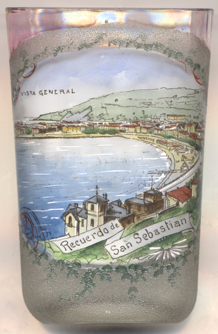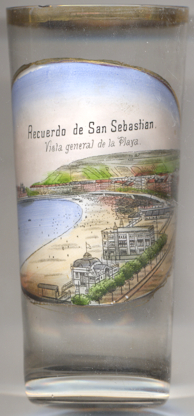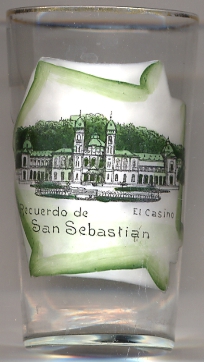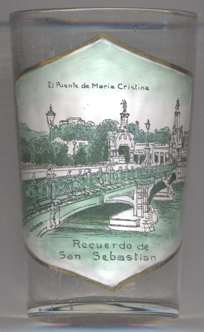

|
| ESPAÑA | Spain |
| Euskadi / País Vasco | Basque Country |
| Gipuzkoa / Guipúzcoa |
Donostia (San Sebastián) is situated on the southern coast of the Bay of Biscay in the Basque Autonomous Community about 20 km from the French border. Capital city of Gipuzkoa, the municipality's population is 186,122 (2011), with its metropolitan area reaching 436,500 (2010). San Sebastián is one of the most famous tourist destinations in Spain. Despite the city's small size, events such as the San Sebastián International Film Festival have given it an international dimension. San Sebastián, along with Wrocław, Poland, was the European Capital of Culture in 2016 (see list).
 The first evidence of human stationary presence in the current city is the settlement of Ametzagaña, between South Intxaurrondo and Astigarraga. The unearthed remains
date from 24,000 to 22,000 BC. In 1014 the monastery of St. Sebastián was donated to the Abbey of Leire by Sancho III of Navarre (Pamplona). By 1181,
the city is chartered (given fuero) by king Sancho VI on the site of Izurum, having jurisdiction over all the territory between the rivers Oria and Bidasoa.
In 1200, the city was conquered by Alfonso VIII of Castile, who confirmed its charter (fuero), but at the same time the Kingdom of Navarre was deprived of its main direct
access out to the sea. In 1265, the use of the city as a seaport is granted to Navarre as part of a wedding pact. After the conquest of the Iberian Navarre and the attachment
of Donostia to Gipuzkoa, Gascons, who had played a leading role in the political and economic life of the town since its foundation, began to be excluded from influential public
positions by means of a string of regional sentences upheld by royal decision in the 16th and 17th century. In 1656, the city was used as the royal headquarters during the marriage
of the Infanta Maria Theresa of Spain to King Louis XIV of France at Saint-Jean-de-Luz nearby. In 1728, the "Real Compañía Guipuzcoana de Caracas was founded
and boosted commerce with the Americas. In 1808, Napoleonic forces captured San Sebastián in the Peninsular War. In 1813, after a siege of various weeks, on 31 August, British and
Portuguese troops besieging San Sebastián assaulted the town. The relieving troops ransacked and burnt the city to the ground. Only the street at the foot of the hill
(now called 31 August Street) remained. In 1863, the defensive walls of the town were demolished and an expansion of the town began in an attempt to escape the military function
it had held before. The city was chosen by the Spanish monarchy to spend the summer following the French example of the near Biarritz. Subsequently the Spanish nobility and the
diplomatic corps opened residences in the 'summer capital'. As of 1885, King Alfonso XII of Spain's widow Maria Cristina spent her summer in Donostia on a yearly basis.
Donostia developed into a fully-fledged seaside resort. Following the outbreak of World War I, San Sebastián became an attracting focus for renowned international figures
of culture and politics, e.g. Mata Hari, Leon Trotsky, Maurice Ravel and others. In 1930, Spanish republican forces signed up the Pact of San Sebastián leading to the
The first evidence of human stationary presence in the current city is the settlement of Ametzagaña, between South Intxaurrondo and Astigarraga. The unearthed remains
date from 24,000 to 22,000 BC. In 1014 the monastery of St. Sebastián was donated to the Abbey of Leire by Sancho III of Navarre (Pamplona). By 1181,
the city is chartered (given fuero) by king Sancho VI on the site of Izurum, having jurisdiction over all the territory between the rivers Oria and Bidasoa.
In 1200, the city was conquered by Alfonso VIII of Castile, who confirmed its charter (fuero), but at the same time the Kingdom of Navarre was deprived of its main direct
access out to the sea. In 1265, the use of the city as a seaport is granted to Navarre as part of a wedding pact. After the conquest of the Iberian Navarre and the attachment
of Donostia to Gipuzkoa, Gascons, who had played a leading role in the political and economic life of the town since its foundation, began to be excluded from influential public
positions by means of a string of regional sentences upheld by royal decision in the 16th and 17th century. In 1656, the city was used as the royal headquarters during the marriage
of the Infanta Maria Theresa of Spain to King Louis XIV of France at Saint-Jean-de-Luz nearby. In 1728, the "Real Compañía Guipuzcoana de Caracas was founded
and boosted commerce with the Americas. In 1808, Napoleonic forces captured San Sebastián in the Peninsular War. In 1813, after a siege of various weeks, on 31 August, British and
Portuguese troops besieging San Sebastián assaulted the town. The relieving troops ransacked and burnt the city to the ground. Only the street at the foot of the hill
(now called 31 August Street) remained. In 1863, the defensive walls of the town were demolished and an expansion of the town began in an attempt to escape the military function
it had held before. The city was chosen by the Spanish monarchy to spend the summer following the French example of the near Biarritz. Subsequently the Spanish nobility and the
diplomatic corps opened residences in the 'summer capital'. As of 1885, King Alfonso XII of Spain's widow Maria Cristina spent her summer in Donostia on a yearly basis.
Donostia developed into a fully-fledged seaside resort. Following the outbreak of World War I, San Sebastián became an attracting focus for renowned international figures
of culture and politics, e.g. Mata Hari, Leon Trotsky, Maurice Ravel and others. In 1930, Spanish republican forces signed up the Pact of San Sebastián leading to the
 Second Spanish Republic. In the aftermath of war, the city was stricken by poverty, famine and repression, coupled with thriving smuggling. However, industry developed and paved
the way for the urban expansion at the end of the 1940s and beginning of the 1950s. As of the 1990s, a major makeover of the city centre was undertaken aimed at enhancing and
revamping the neoclassical and modernist side of San Sebastián's architecture.
Second Spanish Republic. In the aftermath of war, the city was stricken by poverty, famine and repression, coupled with thriving smuggling. However, industry developed and paved
the way for the urban expansion at the end of the 1940s and beginning of the 1950s. As of the 1990s, a major makeover of the city centre was undertaken aimed at enhancing and
revamping the neoclassical and modernist side of San Sebastián's architecture.
Glasses no. 3925 [far left] and no. 4587 [near left] show views of the
 Playa
Playa
The  Balneario La Perla del Océano [near left, no. 4587: centre right] was founded in 1912.
Its architect was Ramón de Cortázar. By 1924, coinciding with the prohibition of gambling in the city of San Sebastián and after several crises,
activity declined until the building became an almost total ruin with the threat of collapse. In the early 1960s, the former spa was transformed into a
festival hall. In 1993, the old building was demolished and reconstructed, preserving its original use as a thalassotherapy establishment and party room.
Balneario La Perla del Océano [near left, no. 4587: centre right] was founded in 1912.
Its architect was Ramón de Cortázar. By 1924, coinciding with the prohibition of gambling in the city of San Sebastián and after several crises,
activity declined until the building became an almost total ruin with the threat of collapse. In the early 1960s, the former spa was transformed into a
festival hall. In 1993, the old building was demolished and reconstructed, preserving its original use as a thalassotherapy establishment and party room.
The  Caseta Real de Baños [near left, no. 4587: foreground] was built at the same time as
the Balneario La Perla and was also designed by Ramón de Cortázar. It took its name from a 'bathing machine' that was constructed after
the royal family chose San Sebastián as a summer court in 1887. The original 'Caseta Real' was a representative wooden hut that was mounted on
rails and could be moved up and down to the shore by means of a steam engine and allowed the royal family to take baths in privacy. In 1910 this was already
in a very poor condition, so that the City Council obtained an administrative concession to widen the promenade and build another building worthy of the city.
The new Caseta Real was inaugurated in 1912.
Caseta Real de Baños [near left, no. 4587: foreground] was built at the same time as
the Balneario La Perla and was also designed by Ramón de Cortázar. It took its name from a 'bathing machine' that was constructed after
the royal family chose San Sebastián as a summer court in 1887. The original 'Caseta Real' was a representative wooden hut that was mounted on
rails and could be moved up and down to the shore by means of a steam engine and allowed the royal family to take baths in privacy. In 1910 this was already
in a very poor condition, so that the City Council obtained an administrative concession to widen the promenade and build another building worthy of the city.
The new Caseta Real was inaugurated in 1912.

The former  Casino and today's Town Hall [left, no. 2861],
located at one end of Parque Alderdi Eder, was built as a casino in 1885. The casino closed in 1924 and the town hall
moved into the building in 1947.
Casino and today's Town Hall [left, no. 2861],
located at one end of Parque Alderdi Eder, was built as a casino in 1885. The casino closed in 1924 and the town hall
moved into the building in 1947.

The  Puente de María Cristina [near left, no. 3287]
spans the Urumea river in order to allow direct access from the old town to the North railway station
and the bullfighting arena Plaza de Toros de Illumbe.
The bridge was built in 1893–1905 and was inaugurated on 20th January, the feast day of San Sebastián.
It was built of reinforced concrete, a novelty at the time, with three arches with spans of 24 metres each.
Its total length is 88 m, its width is 20 m. The name was chosen to honour Queen María Cristina, Princess of
Habsburg-Lorraine and second consort of King Alfonso XII. She was the mother of the later King Alfonso XIII
and regent of Spain between 1885 and 1902.
Puente de María Cristina [near left, no. 3287]
spans the Urumea river in order to allow direct access from the old town to the North railway station
and the bullfighting arena Plaza de Toros de Illumbe.
The bridge was built in 1893–1905 and was inaugurated on 20th January, the feast day of San Sebastián.
It was built of reinforced concrete, a novelty at the time, with three arches with spans of 24 metres each.
Its total length is 88 m, its width is 20 m. The name was chosen to honour Queen María Cristina, Princess of
Habsburg-Lorraine and second consort of King Alfonso XII. She was the mother of the later King Alfonso XIII
and regent of Spain between 1885 and 1902.
[http://es.wikipedia.org/wiki/San_Sebastián;
https://en.wikipedia.org/wiki/Beach_of_La_Concha;
https://es.wikipedia.org/wiki/La_Perla_(balneario);
https://www.facebook.com/watch/?v=476509186935473;
https://www.tripadvisor.com.au/Travel-g187457-c158294/San-Sebastian-Donostia:Spain:Town.Hall.html;
https://en.wikipedia.org/wiki/María_Cristina_Bridge; https://de.wikipedia.org/wiki/Puente_de_María_Cristina;]
![[scale]](lineal.jpg)